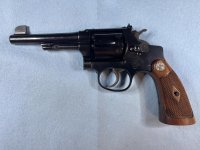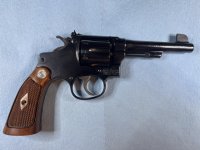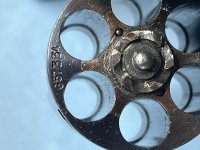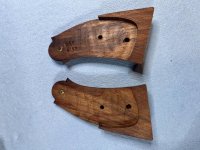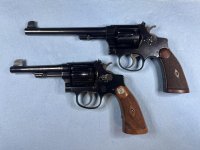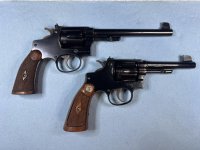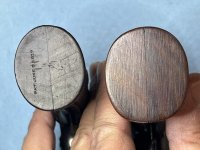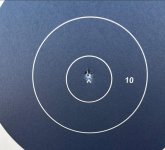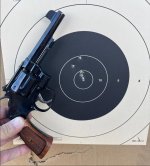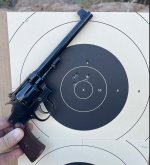Be careful when comparing the group of 196 post war guns with any other RP guns! You will see that S&W was using up left over parts found someplace in storage. I have two of these guns now and had a third. The two guns pictured have different grip medallions and checkering patterns. They were shipped in different boxes. The third gun I had was shipped in a Red Box and had the large pre war medallions.
jcelect
Look closely at the grip checkering borders:
One has sharp corners which are pre war albeit with post war medallions.
The other has post war round corners.
The only interior difference you will find is the hammer black safety. I think the 6" from the 1920's is new enough to have the 1st style side plate mounted safety. Your 4" has the post war sliding bar hammer block safety.
THE 196 32 TARGET RPs made in 1957:
I call these historical anachronisms; the ".32 Reg. Police Target Post War Transitional 'I' frame"
Using a common modern collector term we're all familiar with, these were "clean up guns".
They're obviously quite different than the contemporary I frames of 1957 which were the Models of 1953 New I frames.
They are like the Post War Transitional Models of the late 1940s.
Most features non-conforming to the non-target .32 RP Model of 1953 New I frame (Pre Model 31) guns of the 1957 period! A very convoluted transitional model for sure.
That's because it has 6 screws w/leaf spring, small trigger guard, pre war or post war service style round top rebated sq butt stocks, pre war style hammer spur, and the smaller pre war frame window size with cylinder diameter of 1.267". The pre war sights are obvious, some supplied w/special modified post war blue all steel sight adjusting tool (SAT) to fit tiny sight screws.
But with post war sliding bar hammer block safety, the 3rd and last style straight ejector rod with left hand thread, the 4 line address on frame, 1953 4" (not 4 1/4") barrel w/o patent dates, post war non-chamfered cyl flute sharp corners, post war grooved trigger, and the 3rd type post war non-sculpted thumb piece, (and post 1966 style after I frames became J frames), while all other I frames of the 1957 period have the third type flat latch.
Frame serial # stamped on front grip strap above the strain screw matching all other #'d parts including stocks, 9 locations in all, including rear sight, and both front and rear sight blades. Rear sight has single elevation screw, no elevation check screw.
of the late pre war sights.
Pre war/early transitional post war rebated rear grip strap with post war type 16 lpi checkering, round cornered border on round top stocks with curved nickel plated brass post war medallions. Some have pre war stocks, flat silver medallions and/or sharp cornered checkering borders.
The pre war sights are obvious, supplied w/special modified early post war blue all steel sight adjusting tool (SAT) , (another fluted aluminum handle version exists as well shown below), to fit the tiny sight screws.
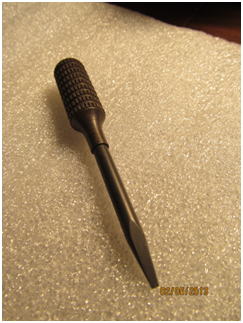
Below with my gun is a SAT that post war transitional target models with pre war sights were also sometimes supplied with and may have been used with this model. Although the fluted version shown below predominates due to the production time frame in 1957 of the 196 .32 Targets. It was likely exclusively for more of the 196 because by that 1957 date of production there were no other pre war target sighted guns being offered since the only others extending into the 1950s, the .22/32 Kit Gun and Target Transitionals ended with the 1953 model!
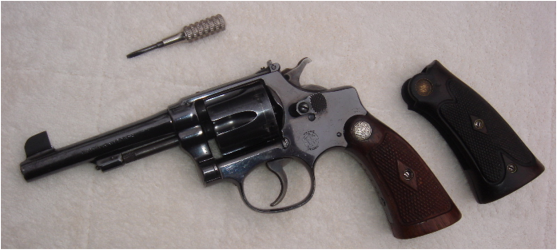
Pre war/early post war hammer with sliding bar hammer block safety, post war grooved trigger, and the 3rd type post war non-sculpted thumb piece, (and post 1966 after I frames became J frames), while all other I frames of the 1957 period have the third type flat latch.
Most features non-conforming to the non-target Pre Model 31 guns of the 1957 period! But it has the 3rd and last style straight ejector rod with left hand thread, no patent dates on barrel and has the 4 line address. A very convoluted transition model for sure. These 196 guns are on page 128, 3rd edition, Standard Catalog of S&W, Supica and Nahas, and pictured on pg. 127.

 When I told her how much I paid for it, she put it right back down and told me to "buy an ugly one and do what you do". I guess I have my orders now.....
When I told her how much I paid for it, she put it right back down and told me to "buy an ugly one and do what you do". I guess I have my orders now.....
